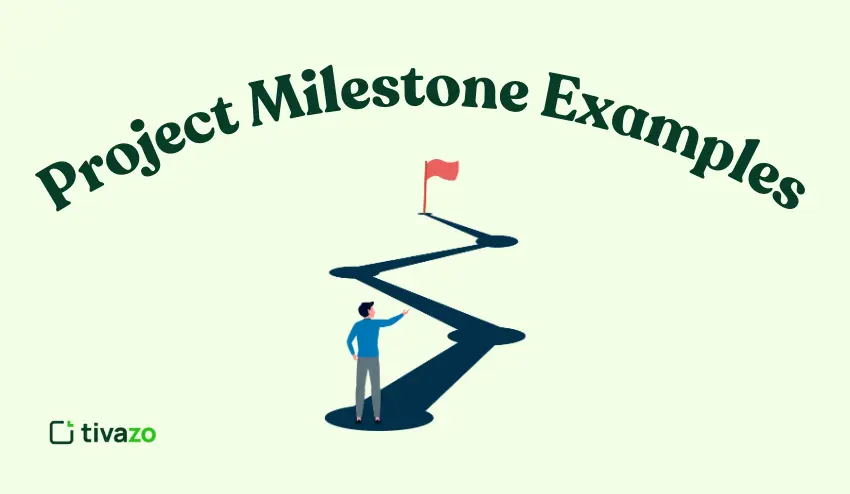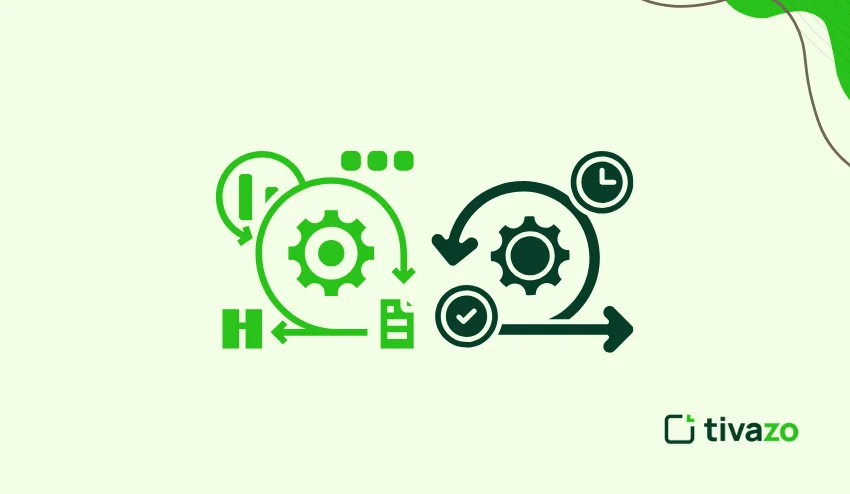All projects have moving components – activities to fulfil, timelines to be met, and deliverables to be submitted. But what do you know to know whether the project is heading in the right direction? This is where project milestones come in.
Project milestones are the markers that indicate to teams, managers, and stakeholders that actual progress is being achieved. Milestones denote the major checkpoints that propel a project, instead of it becoming stalled in endless activities.
In this guide, we will work through the practical project milestone examples that you may use immediately. You will also get to know the reasons why milestones are important, the various types of milestones that you can make, and how to ensure that you manage them. You will also have a structure by the end to streamline your projects in terms of their tracking, communication, and time completion.
What Are Project Milestones?
A project milestone is a major point or occurrence in a project timeline that indicates that progress is being made in the project.
Imagine milestones as stops on a road. They do not monitor every minute step – that is what tasks do, but they underline the most important successes which prove that you have a movement in your project.
An example is: First draft of a design is a task, final approved design file is a deliverable and official sign-off of the design phase is a milestone. Milestones indicate progress, maintain alignment of team members, helps with project management and offer reporting points which are measurable.
Milestones do not concern the work itself, but the awareness of the accomplishment of a significant phase or goal. They provide teams with a strong sense of achievement and direction, which simplifies the planning of the further steps and communication with stakeholders.
Why Project Milestones Matter for Project Success
Project milestones are not a date on the calendar, but they play an important role in planning, monitoring and communication in the lifecycle of the project. Project milestone examples can be used to visualize the progress of the project and what the success of the project would be at each stage.
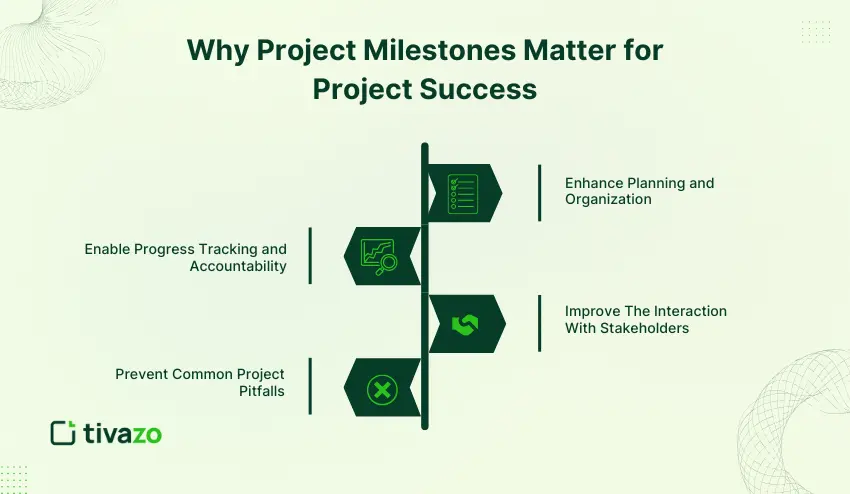
1. Enhance Planning and Organization
Milestones enable the project managers to organize the project in manageable stages. When milestones are established in advance, it becomes less complicated to assign resources, establish achievable deadlines, and predict possible bottlenecks. Project milestone examples, such as requirements completed or design approved aid in the planning of teams.
2. Enable Progress Tracking and Accountability
Milestone tracking gives a good indication of progress. The teams are able to view the stages that have already been completed and those that are underway and where problems could be emerging. The concrete project milestone examples will make everyone understand what is expected and when.
3. Improve The Interaction With Stakeholders
Milestones are communication checkpoints. When reporting progress to a client, the senior management, or even to internal teams, it is possible to refer to project milestone examples, such as prototype delivered or testing phase completed, to provide the stakeholders with a concrete picture of the progress.
4. Prevent Common Project Pitfalls
In the absence of milestones, the projects may experience lack of clarity in progress and scope creep. The teams can get their work done without knowing how it contributes to the larger picture. Examples of project milestones are structured, and they also showcase the main milestones of the project as well as keep the project on track.
Types of Project Milestones
The project milestones may have various forms based on the nature of the project, industry, and objectives. The knowledge of the various types aids in effective planning, monitoring progress, and reporting success by the teams. Here’s a detailed breakdown:
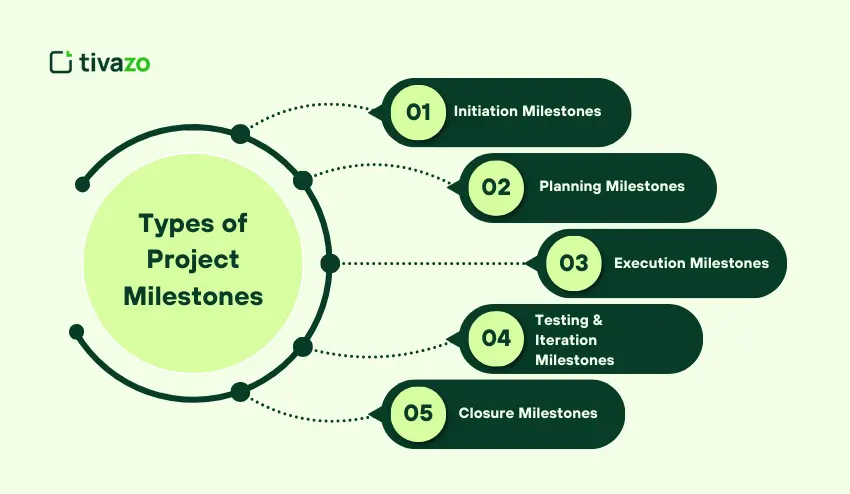
1. Initiation Milestones
These are the formal initiation of a project or a new stage. They establish expectations and maintain a focused team and stakeholders throughout the start. Typical ones are approval of the project, finding funding, or the kickoff meeting where the roles, responsibilities, and initial timelines are defined.
Project milestone examples such as these are useful in setting the point of departure and creating a common vision of the project goals.
2. Planning Milestones
Planning milestones focus on approvals and decisions that define how the project will proceed. Examples include completing the project plan, getting stakeholder sign-off on the schedule, or finalizing risk assessments.
By referencing project milestone examples, teams can confirm that they are ready to move forward with execution without missing key preparatory steps. These milestones prevent confusion and reduce delays caused by misalignment early in the project.
3. Execution Milestones
Execution milestones track major deliverables and significant accomplishments during the project work phase. For instance, completing a prototype, launching a marketing campaign, or finishing a construction phase are common execution milestones.
These indicate tangible progress and help managers gauge whether the project is on track. Using project milestone examples at this stage keeps teams focused on critical outcomes rather than just completing tasks.
4. Testing & Iteration Milestones
These milestones highlight quality checks, testing phases, and iterative improvements. Examples include completing quality assurance (QA) tests, running beta releases, or implementing client feedback.
Tracking these milestones ensures that any issues are caught early and improvements are integrated before the final deliverable. Referencing project milestone examples here helps teams maintain quality standards and avoid costly mistakes later.
5. Closure Milestones
Closure milestones mark the completion of a project or a major phase. Examples include delivering the final product, obtaining client sign-off, or conducting a post-project review. These milestones confirm that objectives have been met and provide an opportunity to document lessons learned. Using project milestone examples in this phase helps communicate final accomplishments clearly to stakeholders and celebrate project success.
9 Project Milestone Examples (Step-by-Step Framework)
To make the milestones feasible, it is useful to observe the project milestone examples in real life in various industries. The following is a step-by-step guide of nine typical milestones that you can make reference to.
Example 1 — Project Kickoff Approval
The project commencement is always a significant milestone. It involves the completion of the project charter, budget confirmation and the kick off meeting. This milestone is necessary to make sure that all people are aware of the project goals, schedule, and tasks.
Micro case study: A software firm organized a kickoff meeting with the developers and stakeholders. They set this milestone, which prevented confusion among the project scope at an early stage and saved delays by 15 percent.
Example 2 — Design Completion
The design phase is a very important milestone. It contains completed wireframes, mockups or architectural drawings, which are ready to be approved.
Micro case study: Within a marketing campaign, the design completion milestone was the completion of all ad creatives before launch to avoid last-minute changes, and the campaign went live on time.
Example 3 — Prototype Release
This milestone is achieved when there is a working model or a sample product. It enables the stakeholders to test functionality and give feedback prior to large-scale production.
Micro case study: A hardware start-up launched a prototype in three months. Monitoring this milestone was instrumental in ensuring that the team detected the flaws in the early stages, which saved the team about 10,000 dollars in production expenses.
Example 4 — Mid-Project Review
The mid-project review is a control point to measure the progress, risks, and make changes where necessary. It assists in avoiding delays and scope creep.
Micro case study: In a construction project, the mid-phase review made sure that the timeframes of the foundation and framing were not behind schedule, which avoided the downstream delays in roofing and interiors.
Example 5 — Marketing Launch Date
The launch date is a significant milestone in the case of marketing or product campaigns. It indicates the end of planning, implementation and testing.
Micro case study: A SaaS company had a product launch as a milestone. The development of cross-functional teams (marketing, sales and engineering) made sure that the launch was completed without any delays.
Example 6 — Testing & QA Completion
This milestone will make sure that the quality standards are achieved prior to the final release. Testing involves functional testing, bug testing and user acceptance testing.
Micro case study: A mobile application team identified QA completion as a milestone. Once it was reached, 2% of reported bugs survived, as opposed to 8% in earlier releases where no milestone tracking was done.
Example 7 — Stakeholder Presentation
One of the milestones is to present progress to the stakeholders. It shares successes and sets the standards and anticipations of the next stage.
Micro case study: In a real estate project, the milestone presentation of floor plan and amenities enabled the stakeholders to approve or demand modifications to save on the cost of making changes in the later stages.
Example 8 — Client Sign-Off
Client approval is an official milestone that establishes deliverables that are satisfactory. It shields the team and the client against misunderstandings or rework.
Micro case study: When working with a SaaS UI UX Design Agency, the client had signs off as one of the design milestone before transitioning to development. This has avoided mistakes and made sure that features are line with the user and business requirements.
Example 9 — Final Delivery / Closure
The final milestone is the project completion. It involves the delivery of deliverables, contract closure and post project review.
Micro case study: A marketing team has finished a campaign milestone and final report and analytics review. The lessons learnt were recorded in case of future campaigns thus making it more efficient by 20%.
Tools & Templates for Tracking Project Milestones
It is necessary to have the appropriate tools and templates to track milestones. Project milestone examples assist teams in visualising what they need to follow, allocate duties and meet deadlines.
Three of the popular choices are as follows:
| Tool | Best Use Case | Pricing Range |
|---|---|---|
| Trello | Simple task boards and visual milestone tracking; great for small teams | Free – $17.50/user/month |
| Microsoft Project | Complex project planning with Gantt charts and milestone tracking; ideal for large projects | $10 – $55/user/month |
| Asana | Task and milestone tracking with timeline view; good for cross-functional teams | Free – $30.49/user/month |
Using templates effectively:
- Reference project milestone examples in your template to list key milestones and deadlines.
- Allocate the responsibility of every milestone to a team member.
- Add dates and dependencies to monitor what has to be done before the subsequent milestone.
- Periodically update the template with changes and progress.
Common Mistakes in Setting Project Milestones (and How to Avoid Them)
Despite the intentions, teams fail to make correct decisions when specifying project milestones. These pitfalls would be learned to make sure that milestones are effective and actionable. Using project milestone examples can help avoid these common errors.
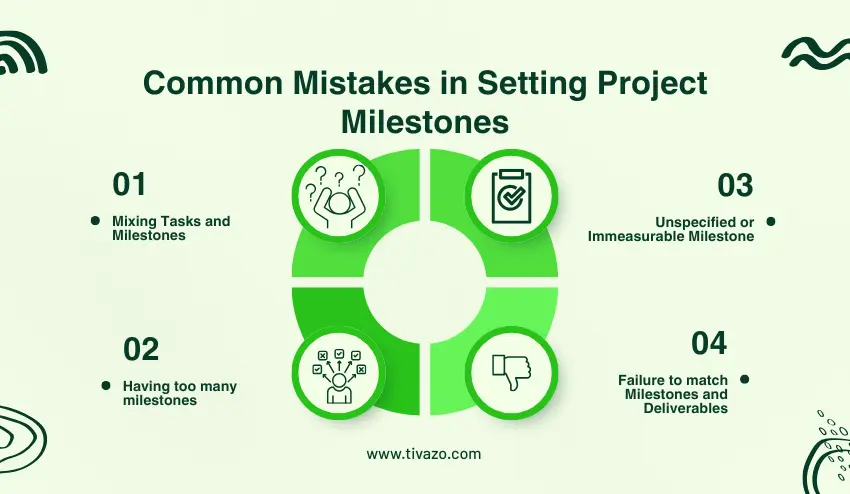
Mistake 1: Mixing Tasks and Milestones
Some teams enumerate all tasks as milestones, thus rendering them useless. It is important to remember that a milestone is not a small step but a major step.
Remedy: Review your project milestone examples and ensure each milestone represents a major achievement or decision point.
Mistake 2: Having too many milestones
Excessive milestones in a project may overload the team and confuse tracking.
Remedy: Pay attention to important stages and deliverables. Use project milestone examples to identify the most impactful checkpoints.
Mistake 3: Unspecified or Immeasurable Milestones
Vague milestones such as ” get work done ” can not be monitored and impossible to track.
Fix: Name milestones with deliverables that can be measured e.g. prototype released or QA done. Reference project milestone examples for clarity.
Mistake 4: Failure to match Milestones and Deliverables
The milestones should be related to actual deliverables, otherwise, improvement cannot be checked.
Remedy: Compare every milestone against its deliverables. Use project milestone examples to ensure alignment.
Actionable Project Milestone Checklist (Quick Start)
The following actionable checklist might be applied to facilitate the process of setting up and monitoring milestones. Using project milestone examples helps make each step concrete and practical.
- Define Project Goals
Determine the objective of the project. Significant progress towards these objectives should be reflected with milestones. - Break Down Project Phases
Break the project into different stages, these stages include planning, implementation, testing, and closure. - Identify Key Deliverables
Identify the physical product of every stage – reports, designs, prototypes or finished products. - Select Milestones in Every Phase.
Select activities which are milestones such as Design Completion or Client Sign-Off. Refer to project milestone examples to guide your choices. - Add Milestone Dates
Establish achievable deadlines of every milestone. Check dates and resources and dependencies. - Assign Responsibility
The position of whoever is in charge of any milestone should be well spelt out. This puts all on a level with each other. - Track and Adjust Regularly
Track the progress and update schedules and reset milestones where needed. Illustrate the progress effectively using tools or templates.
Conclusion
Project milestones are critical to monitor progress, be on schedule and communicate success. By using project milestone examples, teams can clearly identify key achievements and ensure every phase of the project is moving forward.
Be it the launch of a software, marketing campaign, construction project, or event planning, clear milestones can be used to ensure that deadlines are not missed, scope is not creeped, and the team does not get confused.
With the step-by-step model, the tools and templates, and without making the most frequent pitfalls, you can establish milestones that will really help your project succeed.
